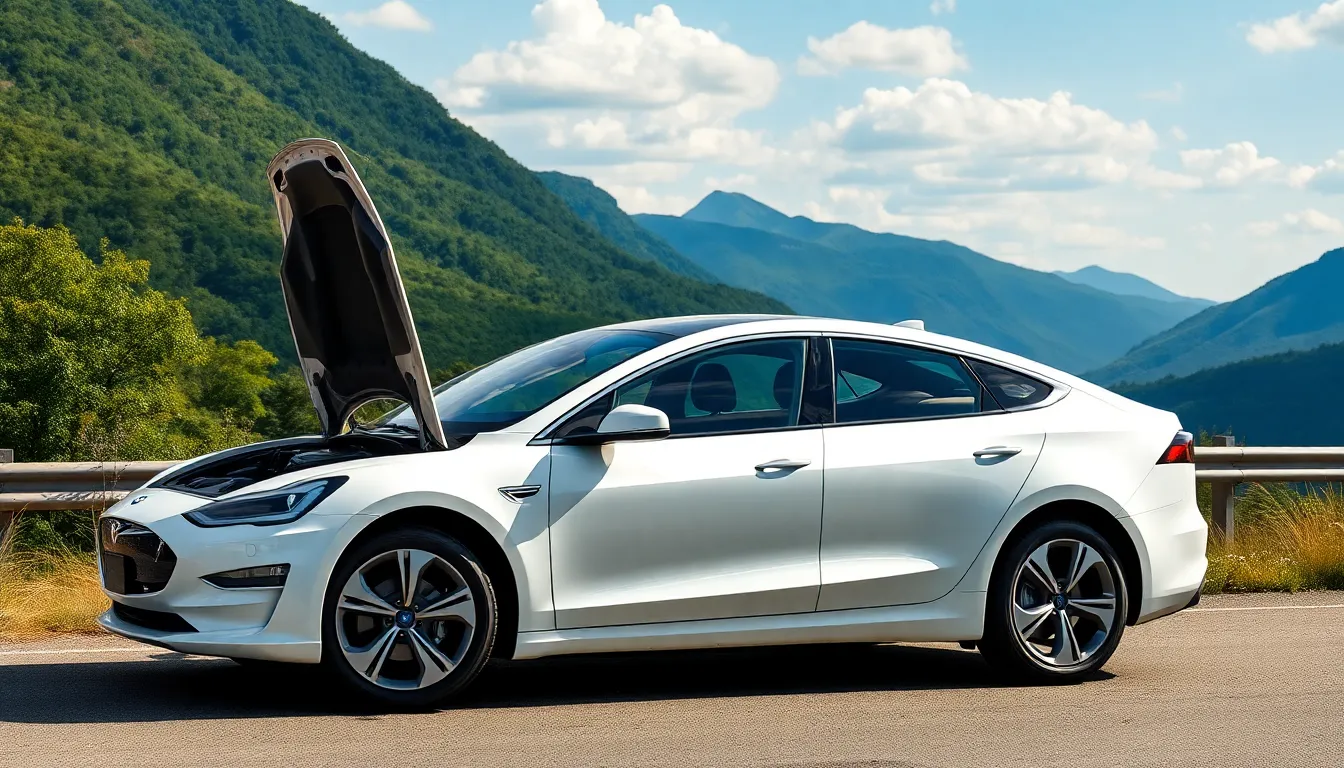As electric vehicles (EVs) gain popularity, understanding electric car range becomes crucial for potential buyers. Range anxiety, the fear of running out of battery power before reaching a destination, often holds back many from making the switch to an electric vehicle. With advancements in battery technology and charging infrastructure, it’s essential to explore how far these cars can truly take drivers on a single charge.
Today’s electric cars boast impressive ranges that can rival traditional gasoline vehicles. Factors like driving habits, terrain, and climate can influence how far an EV can go, making it vital for consumers to consider their unique needs. This article delves into the intricacies of electric car range, providing insights that empower drivers to make informed decisions about their next vehicle purchase.
Table of Contents
ToggleUnderstanding Electric Car Range
Electric car range refers to the maximum distance an electric vehicle (EV) can travel on a single charge. Understanding this aspect is crucial for potential buyers, as it significantly impacts everyday usage.
Definition of Electric Car Range
Electric car range is defined as the total miles an EV can cover using its battery power. Range is typically measured in miles and varies between models based on battery capacity, efficiency, and driving conditions. For example, a Tesla Model 3 can achieve a range of up to 358 miles, while the Chevrolet Bolt EV offers about 259 miles. Knowing the range helps consumers assess if an EV meets their travel needs.
Factors Affecting Electric Car Range
Several factors influence electric car range, including:
- Battery Size: Larger battery packs generally provide greater range. For instance, a 75 kWh battery offers better mileage compared to a 50 kWh battery.
- Driving Habits: Aggressive acceleration, rapid braking, and high speeds can decrease range, impacting overall efficiency.
- Terrain: Hilly or mountainous terrain increases energy consumption, thus reducing the distance an EV can travel before needing a charge.
- Weather Conditions: Cold weather can lower battery efficiency, while high temperatures can also affect range.
- Accessory Use: Utilizing air conditioning, heating, or other electronic features draws additional power, influencing available range.
These factors combine to define an electric vehicle’s practical range and inform consumer choices. Understanding these elements helps potential buyers select models best suited to their lifestyle.
Key Technologies Influencing Range

Electric car range significantly depends on technological advancements. Key innovations in battery technology and regenerative braking systems enhance performance and efficiency.
Battery Technology
Battery technology plays a crucial role in determining electric vehicle (EV) range. Lithium-ion batteries dominate the market due to their high energy density, allowing for more energy storage within a compact size. Manufacturers continue to innovate, creating batteries with higher capacity and faster charging capabilities. For example, solid-state batteries promise improved range and safety compared to traditional lithium-ion counterparts. Tesla’s energy-dense 4680 cell design exemplifies advancements enabling vehicles like the Model Y to achieve over 300 miles on a single charge. In addition, researchers explore sustainable materials, which could further boost efficiency while reducing environmental impact.
Regenerative Braking Systems
Regenerative braking systems contribute significantly to extending electric vehicle range. These systems capture kinetic energy generated during braking and convert it into electrical energy, which recharges the battery. This process reduces reliance on external charging stations and enhances overall efficiency. For instance, vehicles equipped with effective regenerative braking can recover up to 70% of the energy typically lost during braking. Tesla, Nissan, and BMW integrate these systems, allowing drivers to experience a noticeable increase in range during stop-and-go traffic.
Comparing Electric Car Range
Electric car range varies significantly among models. Understanding these distinctions helps consumers identify which vehicles fit their needs.
Top Electric Cars by Range
| Model | Maximum Range (miles) |
|---|---|
| Tesla Model 3 | 358 |
| Tesla Model Y | 326 |
| Ford Mustang Mach-E | 312 |
| Chevrolet Bolt EV | 259 |
| Hyundai Ioniq 5 | 303 |
| Kia EV6 | 310 |
| Volkswagen ID.4 | 250 |
Top electric cars prioritize range, with performance-driven designs pushing boundaries. Tesla dominates the market with its long-range models, while alternatives like the Ford Mustang Mach-E and Hyundai Ioniq 5 show substantial range capabilities. Each option considers consumer demands for longer drives without frequent charging.
Range vs. Price Analysis
| Model | Price (USD) | Range (miles) | Price per Mile (USD) |
|---|---|---|---|
| Tesla Model 3 | 40,240 | 358 | 112 |
| Ford Mustang Mach-E | 43,895 | 312 | 141 |
| Chevrolet Bolt EV | 31,500 | 259 | 122 |
| Hyundai Ioniq 5 | 39,950 | 303 | 132 |
| Kia EV6 | 40,900 | 310 | 132 |
Range influences pricing, affecting overall value. Electric cars with longer ranges often come at higher price points, creating a price-per-mile ratio to evaluate. For instance, the Tesla Model 3 offers competitive pricing with maximum range, making it a cost-effective option. Understanding this analysis helps buyers assess their budget against the range capabilities of various electric vehicles.
Real-World Range Experiences
Real-world range experiences reflect the practical aspects of using electric vehicles (EVs) for daily travel and long distances. Understanding these experiences helps potential buyers navigate range expectations and capabilities.
Long-Distance Travel in Electric Cars
Long-distance travel is increasingly feasible in electric cars, with many models offering impressive range capabilities. For example, the Tesla Model S enables drivers to cover up to 405 miles in one charge, making it a viable option for road trips. Additionally, charging infrastructure, including fast-charging stations, supports long-distance travel by minimizing downtime to recharge. With tools like route planning apps, drivers can effectively manage their journeys, ensuring adequate charging stops. Electric vehicles, such as the Ford Mustang Mach-E, also provide features like battery management systems that optimize energy use during extended drives.
Impact of Driving Conditions on Range
Driving conditions significantly affect the range of electric cars. Factors such as terrain, weather, and traffic influence energy consumption. Hilly terrain can reduce range due to increased energy demand, while flat roads typically enhance efficiency. Cold weather impacts battery performance, often reducing range by 20% to 40%, as maintaining cabin comfort requires additional energy usage. Conversely, optimal weather conditions, such as moderate temperatures, can help EVs achieve their maximum advertised ranges. Traffic conditions also play a role, where stop-and-go driving can lead to inefficiencies relative to highway speeds, affecting overall distance traveled on a single charge.
Electric car range plays a pivotal role in the decision-making process for potential buyers. As advancements in battery technology and charging infrastructure continue to evolve, the capabilities of electric vehicles are becoming more impressive. Understanding the various factors that affect range helps consumers choose models that align with their lifestyles and travel needs.
With options available that can rival traditional gasoline vehicles, range anxiety is gradually becoming a thing of the past. As more drivers embrace electric vehicles, it’s clear that the future of transportation is not only sustainable but also increasingly practical. Making informed choices will empower individuals to enjoy the benefits of electric mobility without compromise.






